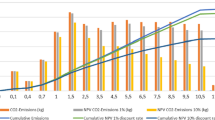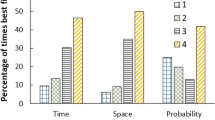Abstract
Environmental economics has been much occupied with “the discount rate,” which is the value of future costs and benefits relative to present costsor benefits. But at least as important is the question of whatshould be discounted, that is, what the value of those future environmentalbenefits is to future generations. This paper analyzes the role for futurepreferences and discusses the state of knowledge. I argue that theappropriate discount rate is the market one, and that the real problemis determining future willingness-to-pay. This approach makes clearerthe connection between discounting and the valuation debate.
This paper focuses on two features that have been prominent in that debate:existence value and reference dependence. I argue that thereis a vital connection between the two constructs and that this link yieldsimportant implications for future willingness-to-pay.
Similar content being viewed by others
References
Arrow, K. (1999), ‘Discounting, Morality, and Gaming’, in P. Portney and J. Weyant, eds., Discounting and Intergenerational Equity. Resources for the Future.
Bowman, D., D. Minehart and M. Rabin (1999), ‘Loss Aversion in a Consumption-Savings Model’, Journal of Economic Behavior and Organization 38, 155–178.
Bradford, D. (1999), ‘On the Uses of Benefit-Cost Reasoning in Choosing Policy toward Global Climate Change’, in P. Portney and J. Weyant, eds., Discounting and Intergenerational Equity. Resources for the Future.
Brekke, K. (1997), ‘The Numeraire Matters in Cost-Benefit Analysis’, Journal of Public Economics 64, 117–123.
Brennan, T. (1995), ‘Discounting the Future: Economics and Ethics’, Resources (Summer), 3–6.
Caplin, A. and J. Leahy (2001), ‘Psychology Expected Utility Theory and Anticipatory Feelings’, Quarterly Journl of Economics (February) 116, 55–80.
Cline, W. (1999), ‘Discounting for the Very Long Term’, in P. Portney and J. Weyant, eds., Discounting and Intergenerational Equity. Resources for the Future.
Cropper, M., S. Aydede and P. Portney (1994), ‘Preferences for Life Saving Programs: How the Public Discounts Time and Age’, Journal of Risk and Uncertainty 8, 243–265.
Cropper, M. and D. Laibson (1999), ‘The Implications of Hyperbolic Discounting for Project Evaluation’, in P. Portney and J. Weyant, eds., Discounting and Intergenerational Equity. Resources for the Future.
Dasgupta, P., K.-G. Mäler and S. Barrett (1999), ‘Intergenerational Equity and Social Discount Rates’, in P. Portney and J. Weyant, eds., Discounting and Intergenerational Equity. Resources for the Future.
Dasgupta, P., K.-G. Mäler and S. Barrett (1994), Environmental Encyclopedia. Gale Research.
Flores, N. and R. Carson (1997), ‘The Relationship Between the Income Elasticities of Demand and Willingness to Pay’, Journal of Environmental Economics and Management 33, 287–295.
Hagen, D., J. Vincent and P. Welle (1992), ‘Benefits from Preserving Old-Growth Forests and the Spotted Owl’, Contemporary Policy Issues (April) X(2), 13–26.
Horowitz, J. K. and R. Carson (1993), ‘Baseline Risk and Preference for Reductions in Risk-to-Life’, Risk Analysis 13, 457–462.
Horowitz, J. K., J. List and K. E. McConnell (2001), ‘The Endowment's Effect on Marginal Value’, Unpublished manuscript.
Horowitz, J. K. and K. E. McConnell (2001), ‘Willingness-to-Pay, Willingness-to-Accept, and the Income Effect’, Unpublished manuscript.
Howarth, R. (1996), ‘Climate Change and Overlapping Generations’, Contemporary Economic Policy (October) XIV, 100–111.
Jousten, A. (2001), ‘Life-Cycle Modeling of Bequests and Their Impact on Annuity Valuation’, Journal of Public Economics (January) 79, 149–177.
Kopp, R. and P. Portney (1999), ‘Mock Referenda for Intergenerational Decision-making’, in P. Portney and J. Weyant, eds., Discounting and Intergenerational Equity. Resources for the Future.
Kristrom, B. and P. Riera (1996), ‘Is the Income Elasticity of Environmental Improvements Less Than One?’, Environmental and Resource Economics (January) 7, 45–55.
Laitner, J. and H. Ohlsson (2001), ‘Bequest Motives: A Comparison of Sweden and the United States’, Journal of Public Economics (January) 79, 205–236.
Lind, R. et al. (1982), Discounting for Time and Risk in Energy Policy. Resources for the Future.
Loewenstein, G. (1987), ‘Anticipation and the Valuation of Delayed Consumption’, Economic Journal 97, 666–684.
Loewenstein, G. and S. Frederick (1996), ‘Predicting Reactions to Environmental Change’, in M. Bazerman et al., eds., Environment, Ethics, and Behavior. New Lexington Press.
Loewenstein, G., T. O'Donoghue and M. Rabin (1999), ‘Projection Bias in Predicting Future Utility’, Unpublished manuscript.
Manne, A. (1999), ‘Equity, Efficiency, and Discounting’, in P. Portney and J. Weyant, eds., Discounting and Intergenerational Equity. Resources for the Future.
Markowitz, H. (1952), ‘The Utility of Wealth’, Journal of Political Economy 60, 151–158.
McConnell, K. E. (1997), ‘Does Altruism Undermine Existence Value?’, Journal of Environmental Economics and Management 32, 22–37.
McFadden, D. (1994), ‘Contingent Valuation and Social Choice’, Amer. J. Agric. Econ. 76(4), 689–708.
Metrick, A. and M. Weitzman (1996), ‘Endangered Species Preservation’, Land Economics (February) 72, 1–16.
National Oceanic and Atmospheric Administration (NOAA) (1999), ‘Discounting and the Treatment of Uncertainty in Natural Resource Damage Assessment’, Technical Paper 99-1, Damage Assessment Center, NOAA.
Patt, A. and R. Zeckhauser (2000), ‘Loss Aversion and the Valuation of Environmental Resources’, Paper presented at the ASSA Meetings, Boston.
Portney, P. and J. Weyant (1999), Discounting and Intergenerational Equity. Resources for the Future.
Rabin, M. (1998), ‘Psychology and Economics’, Journal of Economic Literature (March) 36, 11–46.
Rollins, K. and A. Lyke (1998), ‘The Case for Diminishing Marginal Existence Values’, Journal of Environmental Economics and Management (November) 36, 324–344.
Samuelson, W. and R. Zeckhauser (1988), ‘Status Quo Bias in Decision Making’, Journal of Risk and Uncertainty (March) 1, 7–59.
Schelling, T. (1992), ‘Some Economics of Global Warming’, American Economic Review 82, 1–14.
Tversky, A. and D. Kahneman (1991), ‘Loss Aversion in Riskless Choice: A Reference-Dependent Model’, Quarterly Journal of Economics, 1039–1061.
Weitzman, M. (1994), ‘On the Environmental Discount Rate’, Journal of Environmental Economics and Management 26, 200–209.
Weitzman, M. (1998), ‘Why the Far-Distant Future Should be Discounted at Its Lowest Possible Rate’, Journal of Environmental Economics and Management 36 201–209.
Weitzman, M. (1999), ‘Just Keep Discounting But...’, in P. Portney and J. Weyant, eds., Discounting and Intergenerational Equity. Resources for the Future.
Author information
Authors and Affiliations
Rights and permissions
About this article
Cite this article
Horowitz, J. Preferences in the Future. Environmental and Resource Economics 21, 241–258 (2002). https://doi.org/10.1023/A:1014592629514
Issue Date:
DOI: https://doi.org/10.1023/A:1014592629514




